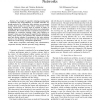PIMRC
2008
IEEE
14 years 6 months ago
2008
IEEE
Abstract—The Media Independent Handover (MIH) architecture is designed to facilitate the signaling and enable seamless handovers in heterogeneous networks. In this paper, we prop...
PIMRC
2008
IEEE
14 years 6 months ago
2008
IEEE
— One of the main task to be done by a cognitive receiver is to sense its spectral environment in order to distinguish surrounding systems from each others. Actually most systems...
PIMRC
2008
IEEE
14 years 6 months ago
2008
IEEE
Abstract—In this contribution we present a decentralized power allocation algorithm for the uplink interleave division multiple access (IDMA) channel. Within the proposed optimal...
PIMRC
2008
IEEE
14 years 6 months ago
2008
IEEE
Abstract—Authenticity and secrecy of broadcast message content is important in wireless sensor networks deployed for battlefield control, emergency response, and natural resourc...
PIMRC
2008
IEEE
14 years 6 months ago
2008
IEEE
—In this paper, the selective time division multiple access (S-TDMA) strategy is studied in the downlink channel. This strategy consists in transmitting data to the user with the...
PIMRC
2008
IEEE
14 years 6 months ago
2008
IEEE
Multihop cellular networks (MeNs) is an extension of single hop cellular networks (SCNs) having benefits of a fixed base station and flexible ad hoc networks. The radio resource ma...
PIMRC
2008
IEEE
14 years 6 months ago
2008
IEEE
—In this paper, we propose a new control method to cover “holes” in wireless sensor networks. Many applications often face the problem of holes when some sensor nodes are dis...
PIMRC
2008
IEEE
14 years 6 months ago
2008
IEEE
—The concept of cooperative relaying promises gains in robustness and energy-efficiency in wireless networks. Although protocols for cooperative relay selection were proposed re...
PIMRC
2008
IEEE
14 years 6 months ago
2008
IEEE
Abstract— Consider the problem of base-station and subcarrier assignment on the downlink of a two-cell OFDMA system with adaptive modulation. The aim is to maximize a common data...
PIMRC
2008
IEEE
14 years 6 months ago
2008
IEEE







